It’s a little Nevada, a bit of Dakota, a reminiscence of Montana, and a slice of South Georgia. But it all happens in western Kentucky.
Four iconic species of gamebirds: chukar, pheasant, Huns, and Bobs, presented in profuse and random salvos over handsome dog-work and distinctively managed shooting fields in the Bluegrass State, with, hold-onto-your-hat: a no-limit bag.
Praise the Lord and pass the ammunition. You’ll need a good bunch of it. You shoot what gets up, and delightfully, you’re never exactly sure what that will be.
It’s the Grand Slam Upland Hunt—the premier billing of a delightful outing called Deer Creek Lodge, near the berg of Sebree. As we were about to discover in the ensuing three days, it’s a gem-dandy.
Honestly, however, though unspoken between us, I think the first order in the initial hour we made the safe haven of Deer Creek . . . for the four of us—Duncan Grant, publisher of Sporting Classics and his son George, a second-year aspirant at the Savannah College of Arts and Design, Bob Timberlake, the celebrated realist artist and entrepreneur, and certainly Yours Truly—was a thankful moment of prayer.
It was the Sunday after Thanksgiving, and we had just survived the most harrowing, over-extended, 14-hour road trip of our lifetime. Persevering through knotted, snail’s-pace and speeding metropolitan, interstate traffic, and blinding monsoon rains upon soaked and bewildering, lane-lost, caldron-black pavement.
I never want to do it again. I’m too damned old and crazy maybe to be warded off by a Cape buffalo, but I’m double-damn scared of big city traffic in dizzying rain.
And it had poured unrelentingly for four days at Deer Creek, too.
But there’s an old, fine mantra among the best of sporting lodge keepers: “You can’t control the weather, and you can’t always and absolutely assure the hunt will be according to Hoyle, but when it comes to the things you can control—you keep them no less than perfect.”
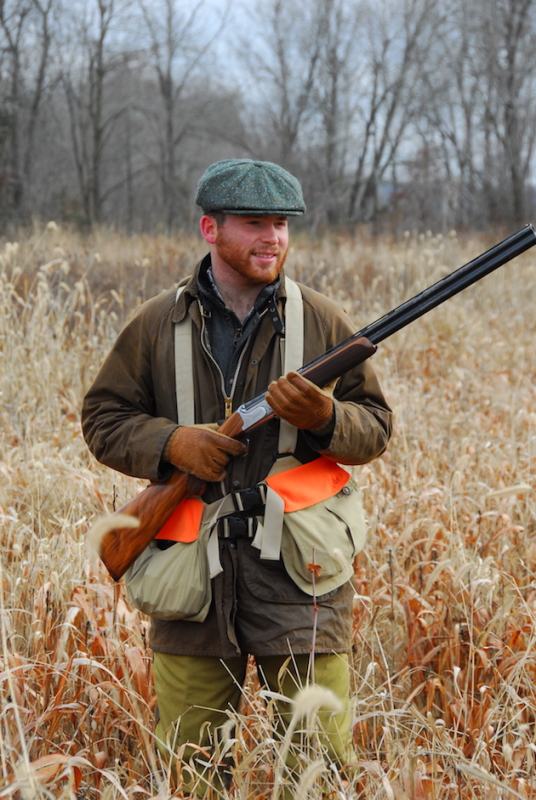
George Grant enjoys a break from college and Kentucky’s upland offerings.
So that when we at last got there a little before midnight, exhausted and frazzled, there was Tim Chappell, PR and marketing manager for Deer Creek, at the gate to greet us and guide us to the Lakeside Lodge, one of three on the expansive property. Inside were Chef Peter Wright Sturdevant and Willie Eblen, the Deer Creek general manager, standing by a table with choice beefsteak, stir-fried veges, and a steaming baked potato. Hot tea and coffee. And soothing, reassuring conversation.
Over the next hour, before a warm, welcoming bed, we were healed.
It felt back-porch comfortable, and indeed, it was the bellwether for the nostalgic brand of hospitality the folks at Deer Creek would serve up for the duration.
As Chappell would tell me later: “We want our cordiality to outshine all else. We want it to feel like family here—the warm, wooden doors on the lodge fronts, the Lazy-Susan round-table at meal-time, congeniality, and informality down to the easy-chair arrangement—we want it to feel like home, Mister Mike.”
Wup! What was that? Sounded like Old Georgia.
Kentucky may have fought largely for the Union in the Late Unpleasantness, but it was never beneath wholly pleasant while these southern boys were there. It felt a lot like the man said, “like home.”
Best yet, the first morning arrives merrily: replete with anticipation, lead-gray, overcast and moody skies, but dry. Well, sorta dry. Soggy, but true to Master Timberlake’s prediction, it never rained. Felt and looked like a good old-fashioned, Thanksgiving-coming-Christmas bird huntin’ day. A green cedars in sedge and red berries on woods-holly kind of day.
Ha! Chef Sturdevant even scares up some grits to go with over-easy soppin’ eggs, slabs of hickory-smoked bacon, and hash browns with jalapeños and cheddar cheese; country biscuits, peppered gravy, and molasses joined the party, and we are well-fortified when Randy Corbett, the main-man guide, shows just by our doorstep about eight for the maiden hunt.
Guns and shells, bags and plunder, chaps and hats, the usual tease and banter, and we’re off. It’s a wonderful world.
Randy narrates the tour to the hunt grounds. All-around, 3,200 acres a-plenty, unfolds the bountiful Deer Creek holding. Broad, rich cultivated bottomlands and side slopes, shouldered by cascading ridges of mature hardwood forest: oak, hickory, maple, and poplar, spectacular when in full autumn color, veined with sparse stands of evergreens.
“We don’t cut trees here unless we absolutely have to . . . don’t clean up blow-downs, just preserve it in as natural a state as possible.”
It’s lovely. No slash piles, no clearcuts, just clean woods, croplands, feed plots, and fringe-lands of CRP and security cover.
Deer Creek exists for the public through the grace of the owners, whose familial passion is whitetail deer. Thus the universal management design.
The hunt program at Deer Creek actually started in 1970 under prior ownership, strictly for whitetail, but—though it may reopen to limited clientele in the near future, with 150- to 160-class or better deer in the offing (the lodge record is 199 and change)—that opportunity is currently reserved for the landowners and family.
A 30-acre lake, flooded naturally so that standing trees, stick-ups, and submerged structures abound, provides a dramatic and beautiful backdrop to the shooting fields, the Lakeside and Upland Lodges.
“When the weather gets too nasty to bird hunt—you see those Arkansas and water blinds scattered around?—we break out the duck gear, have a fine time on released mallards,” said Tim Chappell. “And there’s some huge bass in there, a lot of ’em, that we have a big time with in the summer with clients and kids, and our Wounded Warrior Program.
“We also have weddings, trail rides, five-stand clays, recreational hikes, nature walks, and excursions for the kids across the respective seasons.” So there’s a lot going on here year-round.
But back to our marching order.

Bob Timberlake readies his .410 Winchester 101 as the dogs work a pheasant field of tall foxtail.
The Crown Jewel at Deer Creek—and on this make no mistake—is their Upland Bird Program, and specifically, the Grand Slam No-Limit Hunt. They’ve honed and polished it since the mid-’80s, take great pride in it, and spare nothing in the attempt at making it a rare, superb, and ever more thrilling wingshooting adventure. Which has gained Orvis endorsement since 2004, and awards including Wingshooting Lodge of the Year in 2006, followed by finalist honors in 2014.
In the doing, they take about 800 acres to the ground every spring and reconstruct it by late summer into an old-field network of upland game lands, encouraging natural grasses as much as possible. Which are, before the gunning season, carefully mowed and stripped to provide convenient hunting access—though, foremostly, season-long, natural holding cover for the birds.
So you hunt over ample gray-brown fields and fallow strips of ragweed, sedge, foxtail, beggar lice, briers, and burrs, interspersed with sere-brown, seed-head stands of cultivated millet. Sound something like old-time bird trampings? It’s no accident.
Neither is the pride and effort expended in putting good dogs on the ground—realizing that’s where it all begins and ends. There’s an ongoing average of around 35 flushing, retrieving, and pointing dogs in the Deer Creek kennels, every one reared, trained, and finished on home grounds from a pup.
“Each dog is different,” Randy says, “like a fingerprint. We raise ’em and train ’em that way . . . and the best of ’em go to the Grand Slam.”
Put it all together and it’s a pretty stirring thing, heading out to your first premier hunt here. By the time we reached the hunting fields that first morning by the lake, there was that lovely feverish tickle in your stomach that said “somethin’ happy’s about to happen.”
Guns and shells. Set yer hat on straight. Heigh-Ho!
The hunt formula here is simple and ultimately efficient: a pointing dog and a flushing dog to hunt up and put out the birds, and a brisk, morning/afternoon-long foot hunt down stretching edges of frost-silvered strip cover teeming with the multi-species of birds. The result? Virtually non-stop action from first flush to last.
It’s a released bird hunt, a different one, and an all-day-long fast one. If you relish volume wingshooting; look for a perfect corporate retreat; this is your venue.
Released birds have long-since become universally the necessity for commercial shooting, and as the result hunt managers, as at Deer Creek, have gotten better and better at nurturing and presenting them to near-wild advantage. The line is honed so fine that honestly in some cases it’s almost hard to discern the difference. It almost becomes moot.
I knew wild birds when we had ’em, hunt ’em now when I can where still we do. They’ll always be the epitome, the difference between bronze and gold. But the one happiest thing I think you have to say about released birds is that they offer constantly recurring episodes of the things we love most: the dogs, the point, and the flush.
So it was that first morning and afternoon, and every morning and afternoon hence.

Rizzini’s Aurum, with 28-inch barrels in 20 gauge, proved more than capable on all the bird species present at Deer Creek.
“Who we got down first, Randy?”
Our man unlatches the box, and out rushes an upstanding white, black, and ticked setter. He stands boldly on the tailgate, eyes livid with desire, suffering the moments it takes to affix a beep collar.
“Well, we got Bodie, here,” he allows, as he lets the setter off the truck. “And Sadie,” he proclaims, as he trips the latch on the companion box, and out pops an orange and white English Cocker.
“Sadie’s seen the wars,” he says. “She’s ten now, but most days you’d not know it. She’s been a good ’un.”
She flits here and there, tail popping, spaniel merry, a bounce-a-step. Gotta love it!
But now it’s business. Randy sends the setter, orders the cocker to heel. We barely have the guns uncased and limbered when, 40 yards into the first cast, Bodie skids sideways, running nose-square into hot scent. He’s seized mid-gears, down tight, 12-high tail and six o’clock nose.
I don’t care how many times you’ve seen it, you live for the next. They’re all dissimilar, and all the same. A point is a priceless gift, bestowed uniquely by every dog, a beautiful and miraculous thing. In the heat of a volume shoot, sometimes it’s sadly taken for granted. But never by a true dog man.
The cocker is trembling, riveted to the setter, begging the word to go. The blaze in those hazel eyes could set the woods afire.
Randy bids us up, Duncan left, Bob right. We’ll trade around as we go. Before they can make it and the cocker can be sent, a fleet dozen quail blow up, borne asunder. Sounds like playing cards against bicycle spokes. Bob spins in pure reflex; the .410 thumps and tumbles the one bird that hooks hard-by right. The rest are safely away and gone before another shot can be fired.
Well, that’ll put the notion in your noggin: “Get the hell up and be ready!”
It ain’t long. Fifty yards more and the setter’s back caves. He drops to “Ca’ful,” takes two more steps . . . then another three . . . and again—the birds are running. Bodie plays a meticulous game of tag.
Well, we’ve got a remedy for that.
“Sadie!” That dog’s ten? She’s gone, leavin’ skid marks where she left. Ha! Watch this! She’s past the still roading setter, goes 30 feet more, hooks back. Slam on!
Up! go the birds. Rooster! White, green, burgundy, and gold, cackling, up and peeling to port. Then the hen, hard behind him, straight-away right. Duncan leans into his gun, follows a proper moment, pulls. A splatter of colored feathers and the rooster goes abruptly inert, dropping with a thud. Bob has the starboard bird, pulls, Whoom! the bird staggers, towers; Whoom! and tumbles clean.
Sadie’s off for the pick-up. Out-’n-back, out-’n-back. Jig-time.
“Watch the flusher!” Randy shouts, “Watch the flusher!”
The setter’s slammed to stop again, 20 feet farther, the cocker in a fragrant frenzy, back ’mongst the cover. Out they go! Three Huns. Climbing, rolling, two right, one left. Double guns bark together. Twice, then twice again. Duncan misses with the first, connects slam-on with the second. The bird drops hard at the edge of the woods. Bob folds the far bird like it had run into granite, then spins, trying to catch the crossing near, pulls as he’s losing his balance. Dead bird!
Pretty nice, Gents.
All right, young George, it’s Me and Thee.
Forty yards more, and Bodie lays down the calling card, struck into stylish splendor by a thickened copse of millet and foxtail. Five yards ahead, three chukars break cover, then dart back in. It’s tag again. Bodie breaks off, swings a loop, back-tracks. Bang! Stops ’em dead. Now wasn’t that pretty!
“Back!” Sadie has them up before they know what hit them. Two right, one left, which George, leaning into the little Rizzini, collects, just as Sadie—who’s hard under the tumbling bird—almost catches mid-fall. I have the business on the right. One bird hangs too low, a wet flier. The other feints a straightaway, then tacks oblique. But not far. He folds dead and Bodie delivers him to Randy priority mail.
“Watch the flusher,” Randy hollers. Ah, Sadie my Girl.
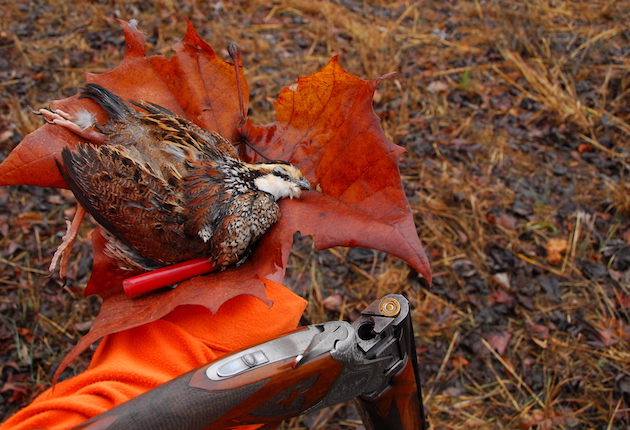
One shot, one bird.
We barely have time. The happily bouncing little cocker, back in the cover ten yards ahead, has mined gold. A tight mother lode of Bobs explodes like powder in the flash-pan, P-Pbl-pbbl-bl-ll-hhhh! Ever try to capture it in a word? Ain’t easy.
Whatever, it scares seconds off your life and happens faster than I can write it.
We’re by a thickly wooded ditchline. In a blink, the birds peel and corkscrew low and out, fast away, dodging the tree trunks. Shades of wild here, Boys! George and I both blister trees the first shot, manage to catch a bird each with the last.
The cocker’s still threading the cover, tail a merry blur of “it ain’t over . . .” Out go the lay birds! Two come hard by me, tearing apart, speeding, twisting, right and left. I really don’t hear the gun, but the birds blow limp, one then the other. George makes a beautiful off-balance shot at a cock-bird on the off-side.
What can you say? Best, not much. Just be thankful. Those are the kind that make you feel a whole lot more important than you are.
And that’s a fair sample of how constant, fast, and diverse the action was.
It had rained four days. We had worried about wet, weak fliers. The birds were doing damn well.
Intermission. Lunch bell’s ringin’. Oh, my. Steaming hot, roasted red pepper, and vine-ripened tomato soup with sour cream and chives. Fried quail po’ boy salad in French baguette with tomato, red onion, dill pickle, fluffy iceberg lettuce, and a spicy Cajun remoulade dressing. The Man’s done it ag’in.
For the afternoon and the following morning, the mood stays cloudy and gray, dry, just December-come-Christmas perfect.
Off the bench come Edge, a tri-setter; Huey—or Mister Hubert, if you please (Mister Hubert if you don’t please), macho, little “stick-it-to-’em,” black-and-white, parti-colored cocker; and Crooker (Crook), parti black-and-white cocker also, cute as the dimple above your girlfriend’s belly button and only two, who’s already good enough to give the Old Guard “what-for.”
The dogs are different. The beauty is the same. All handled quietly and sparsely, with great rapport.
You know—a thing about preserve pointing and flushing dogs. In my mind this trip, Bodie, for example, was a great preserve dog. My guess is, notwithstanding the range question, he would have been a great dog in any venue. If you watched closely, again as an example, anytime the wind was wrong, he’d swing out front and grab a chunk back, now with it in his nose. You don’t teach a dog that. If they’re good at the numbers, they learn it of their own. He was steady through multiple flushes, shots, downed birds, and flusher retrieves, on each and every stand, as long as he still had birds in his nose, until his flushing companion pushed them all to flight. That’s not easy for a dog. Try training for it.
We get haughty sometimes and brag boldly about our field trial dogs, and class wild bird dogs, as we should. It’s a different world. But it’s good to remember as well that a dog doesn’t get to choose his venue; we do. He just does his best wherever we assign him. And a great dog is a great dog wherever, and deserves our everlasting respect for it. It’s a thing a lot of folks miss.
Enough from the pulpit. Back to the choir. In the kitchen that evening, at the Upland Bird Lodge, Peter and his staff were still in rare harmony.

From left: George Grant, the author, and Bob Timberlake.
But savor, now, our surroundings too. Because Deer Creek’s Upland Lodge is indulgently spectacular, occupying a high knoll and overlooking the lake and a goodly portion of the overall property. Think contemporary elegant, and the cover of Architectural Digest, and you’ve a grasp of what the exterior impression of the 10,000-square-foot structure imports. Great vertical panels of glass comprise the largest space of the walls. Which, when you’re inside, as we are now, sustain the translucent intimacy with the world outside: the mood of the day, the trees and hillsides, the far meadows, the shimmer of the water in the lake below. Imagine, in autumn when the trees wear their fall colors under October sunshine, how brightly reigns the temperament and visage.
The ceilings of the main floor atrium are cathedral, with the dining hall at one end and a large cordiality area in the other, spacious and uncluttered with sofa-comfortable lounging. The interior wall appointments are thoughtfully displayed and meticulously chosen: a North American big game group, whitetails prominent, on the west wall; an eclectic African group including kudu and gemsbok on the east. Affecting sculptures and paintings of dogs and birds prevail throughout. No question of the mission here.
A large wet bar has center stage on the north wall, inviting libations over the day’s stories, the countertop of glass presenting to optimum advantage the copious and unique, multi-colored collection of shotshells beneath. Very appealing.
Beneath the main hall on the lower vestibule are the well-appointed and luxurious sleeping quarters. The décor of the threshold foyer is striking, with large dioramic, glass cabinet, museum-quality presentations of ringneck and bobwhite families either side, the bedrooms opening from its adjoining three dimensions.
Despite the overall sense of elegance, the down-home hospitality of the staff is pervasive, and if you feel like kicking your boots off, the invitation is ever open. Willie probably already has.

The author levels his gun for another shot.
“We want to make first-timers life-timers,” Willie says.
The second afternoon we don gum boots, break out the big guns under steel-gray skies, and have a go at the ducks. From a spacious old Arkansas blind situated on the break of the creek channel, opposite a long line of standing, dark timber. We’ve got 25 “mallets” to collect, the episodic limit here. “Tumble the greenheads, boys, spare the susies.”
“Here they come, here they come.” It’s a high old time, pass-shooting the far birds through the trees. Hit and miss, but greatly gratifying when they crumple. Belle, our lady Lab, ten now, whines and frets as a three year old, given a too infrequent chance to be on the water again. It’s beautiful the zest, still, in those golden eyes, the zeal in her retrieves.
Twenty-five comes too soon.
Gosh, now we have to eat again. Stepping out of the Lakeside Lodge, the other three of us, there’s Bob, hanging spent, red duck shells on the little tree just off the porch. He reminds us Christmas is coming. “Cartridge on a pear tree,” he quips.
Only Bob.
We walk up the hill, to the Upland dining room, reminiscing about the first two days, laughing and jesting over our foibles, enjoying again together the warm and underlying sentiments of our shooting fraternity. Dreading, after tomorrow’s morning hunt, that it will trail to end. This has been a happy place.
Cocktail appetizers: oyster mushrooms, bacon-wrapped sweet chili duck breast, mini shrimp and venison sausage with cream cheese, Wellingtons in puff pastry with cilantro and bourbon glaze. Rescue me, please. Then Maestro Sturdevant (also an actor, New York masculine model, musician) conducts again, with Rebecca Marcote and Stacy Coleman. They have the Lazy Susan loverly with Caprese salads, then decorate with the entrées moreover—filet mignon Oscar: beef tenderloin anointed with buttered, jumbo lump crab meat, and hollandaise.
But wait now! The final salute: house-rendered ice cream laced with mint chocolate chip, salted caramel, and French vanilla.
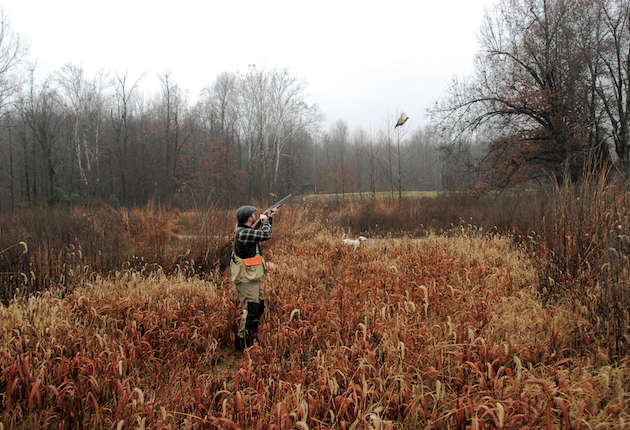
George Grant takes on, and down, a high flyer.
You just have to surrender. Deliciously replete, mellow and tired, we’re off for bed.
For the first time in the three days dawn breaks clear, and Lord, on the eastern horizon looms the grand, molten globe of the rising sun. The sodden world sings Hallelujah! and every creature, us-the-more, rejoices in the chorus.
We’re off early, spirits a-soar. Randy turns out Pete, a young, dramatically marked and masked, black-and-white pointer; his English compadre, joyfully again, our little equally parti-pretty cocker friend “Crook.” They put on a show, the stark and beautiful cinematography of their markings stunning and stylish under the full sunshine against the blond-gold tops of the foxtail, the russet and auburn of the millet heads, the silver-gray and chocolate stands of ragweed.
“God gifts special mornings,” Duncan said. Nods all around.
I kept glancing at my watch, wanting to slow the ebb of the hunt. But, of course, couldn’t. I remember near the finish, Pete slammed stopped, regally jacked on tiptoes, leaning into the sun-warmed scent so hard he literally tottered.
“Crook!”
The little Cocker went so hard he flung himself into a last, long, high leap of faith into the cover, a thrilling ebony-and-ivory blur, landing smack-dab-top of the skulking birds. Huns! Our four guns spoke as one, in differing directions— Bob and Duncan with tremendous doubles—and we knocked down the entire rise.
I guess if it had to end, that was a good place to leave it.
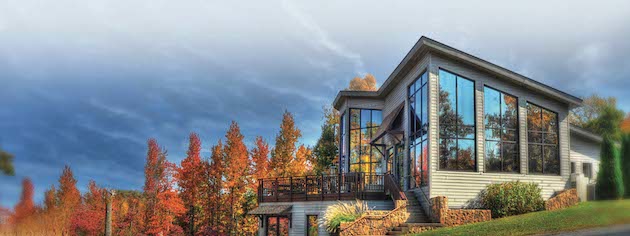
If You Want To Go
Constant action, upland gunning amid a grand ambiance. 270-835-2424, deercreeklodge.net
Field Test: Rizzini’s Aurum
Battista Rizzini launched Rizzini shotguns in 1966, almost immediately earning international acclaim for his articulate Italian designs and their efficient performance in the game fields.
The Aurum, our test gun—the company’s best-selling over/under—sustains that reputation quite well. Featuring a warmly figured, hand-checkered stock of Turkish walnut, in English or Prince of Wales; flat-forged frames adorned with game scenes in relief; barrels of chrome moly, it’s a sleek boxlock offered in coin, case, or light coin and gold inlay. It has the look and feel of a nimble bird gun, and so it proved.
Ours was a well-scaled 20 gauge with POW grip and 28-inch gloss-blue tubes, nicely appointed with coin finish and bird scenes. All four of us shot and enjoyed it during the hunt. The consensus: it’d be awfully nice to take home. www.rizziniusa.com

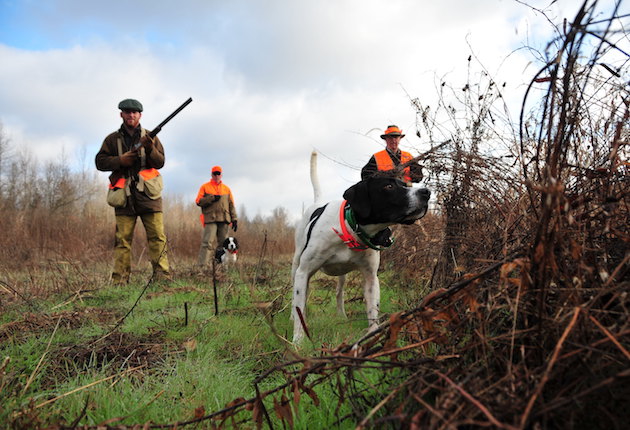
This sounds very grand to me! When one gets older this makes for a more comfortable hunt. For me it is about the dog work and they really don’t care if its wild birds or released birds.
All due respect, but to truly experience chukar hunting go West. There in the canyons of the Owyhee River in Oregon you will hunt the bird on his terms and gain a large measure of respect and know how special it is to hold a few chukar in your hands at the end of a long hard day. Trust me it is well worth the trip and the EFFORT.